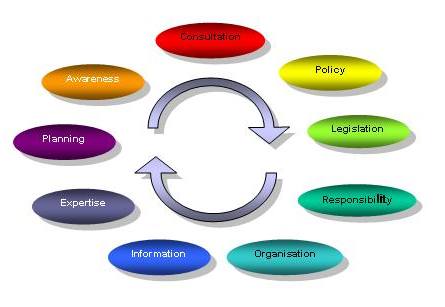Programme for Water Governance in Fiji
Introduction

 Water governance is a complex and sensitive matter. Water governance in Fiji was considered according to the nine elements in the diagram. Each element needs specific consideration but water governance will not be successful unless all the elements are covered.
Water governance is a complex and sensitive matter. Water governance in Fiji was considered according to the nine elements in the diagram. Each element needs specific consideration but water governance will not be successful unless all the elements are covered.
Fiji was chosen as the country for the national water governance pilot, partly because of initiatives and commitments already made by the Government of Fiji.
The pilot ran for eleven months, during which time an international consultant made short visits to help progress the development of strengthened arrangements for water governance at the national level in Fiji.It was hoped that the pilot would provide a basis for the Government to introduce comprehensive water management arrangements in the following two to five years.
Approach to Water Governance
The National Water Committee of Fiji, which was established by the Government in 1998, has been the key body for coordinating action on water governance. The Committee discussed and accepted a ‘building block’ concept for identifying the elements of water governance that require attention.
Within the scope of the pilot it was possible to make significant progress in the first five elements – policy, legislation, coordination, organisation and information, while identifying some areas for further development in the remaining four elements.
Initial visit for the PfWG pilot
The initial visit took place in August and September 2005. During the visit, the consultant:
1. scoped the water governance requirements and develop an outline program for the pilot (to run from September 2005 to August 2006);
2. assisted in the development of the national water policy draft which was later approved by Cabinet (in Decmber 2005) as an interim policy, subject to consultation
The national policy was interim only because further work was needed on some key issues, such as native land ownership and water rights. Important elements in the national water policy draft are:
- a statement of the importance of the government’s role in managing and allocating water for all uses:
- a set of principles and objectives for water management, including sustainable exploitation and to achieve social and environmental benefits for the country;
- a commitment of the Government to take further action on (i) developing comprehensive water resources legislation, (ii) establishing a high level advisory body on water issues, and (iii) establishment of coordinated information management of water data and information.
Subsequent progress
Between November 2005 and August 2006, four further visits were made by the international consultant. The following major activities were undertaken:
- November 2005 a two-day workshop on Water Reform Strategy for Fiji
- May 2006 a one-day workshop on Water Resources Legislation
The outputs from the workshops were used to develop proposals for the following:
- a report on further development of water policy;
- an outline document for water resources legislation;
- a proposal for national coordination for water resources and provision of advice to the government;
- an analysis of national organisation and responsibilities related to water resources, with a proposal for develoing a water resources management capability within government;
- a report on water resources data and associated responsibilities.
The outcomes of the workshops were discussed by the National Water Committee in September 2006 with a view to further action on the key elements of water governance covered by the Programme for Water Governance pilot.
These are considered to be the main building blocks for achieving a water management framework which is capable of handling the steadily progressing pressures and trends affecting water resources in Fiji.
Some work was undertaken with financial support from ESCAP in 2002 on the identification of water management requirements in Fiji. At that time the Cabinet had decided:
- to set up a coordinating committee to review and advise the government on water management and water policy
- to develop a national water policy.
Under the ESCAP assistance, some initial suggestions were made about a water management strategy to advance Fiji’s capability to control and organise the development and protection of its water resources more actively and effectively.
Since that time, the following has been accomplished:
- an initial draft water policy document has been developed, with leadership from the Mineral Resources Department;
- draft amendments to the Minerals Act have been circulated for comment: the amendments would give control of groundwater extraction to the Minister for Land
- and Mineral Resources and would enable groundwater protection zones to be declared.
The amendments to the Minerals Act are considered an interim measure to enable greater control over the extraction of groundwater by important developments, particularly were such developments are close to one another and may conflict. Similarly, it brings in protection measures to maintain the quality of groundwater.

















